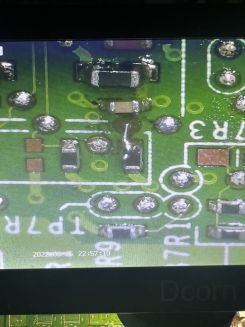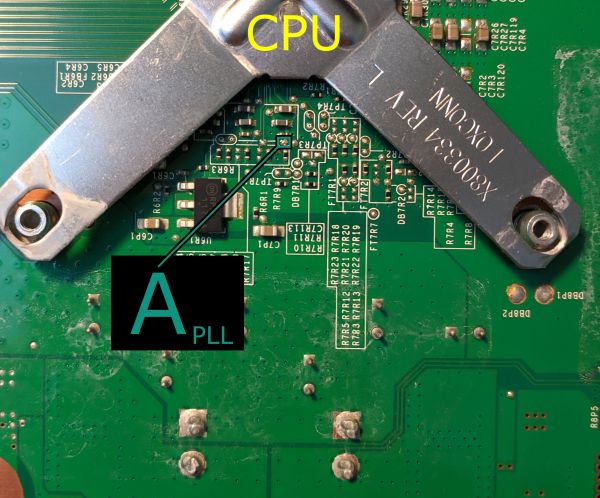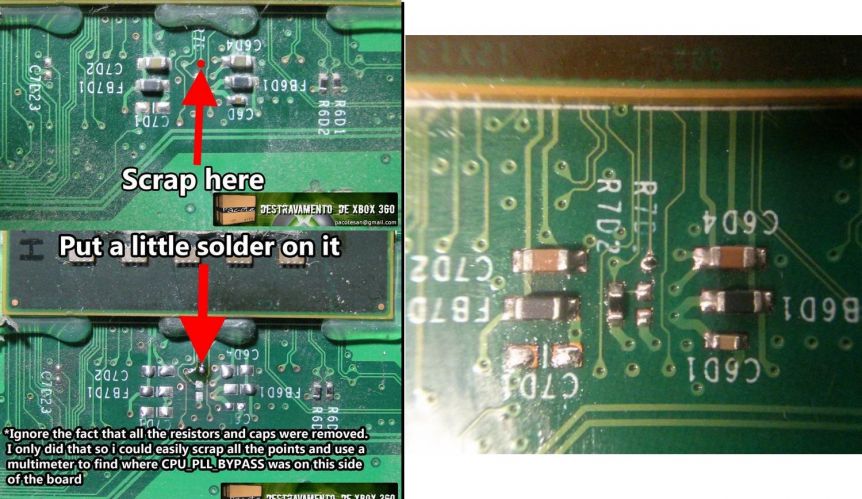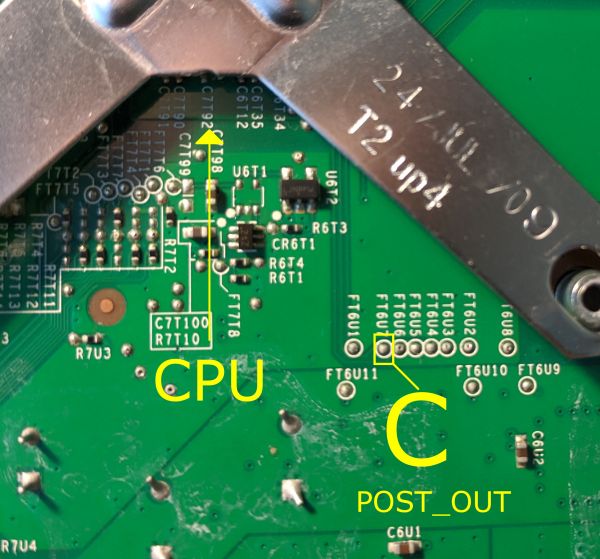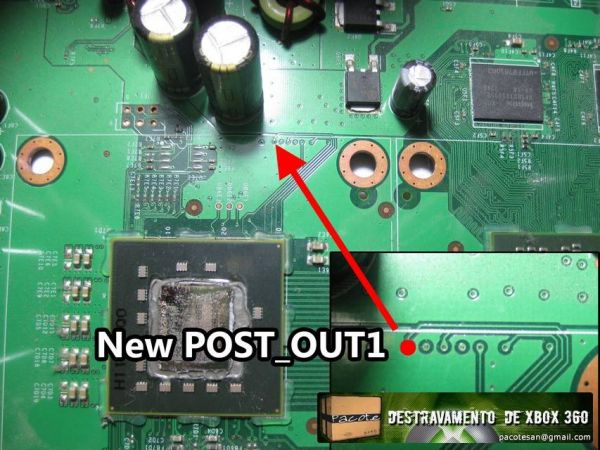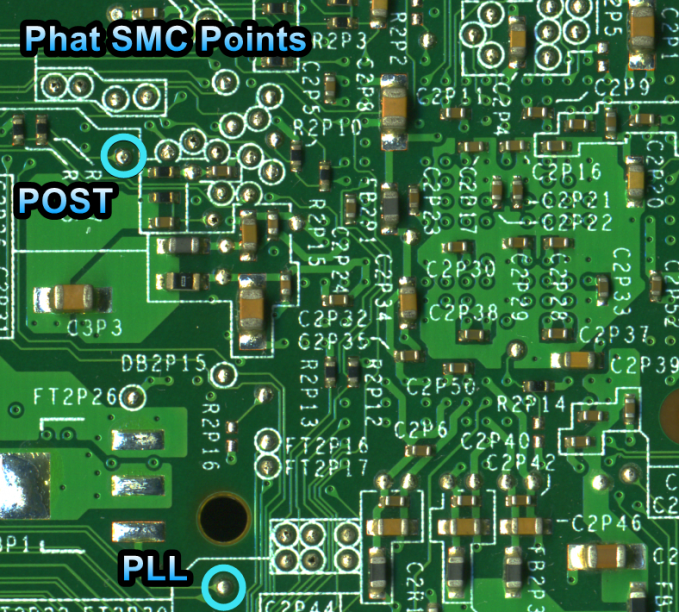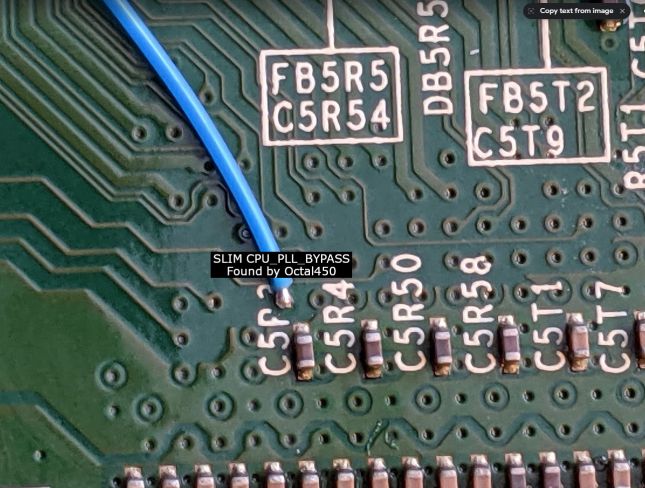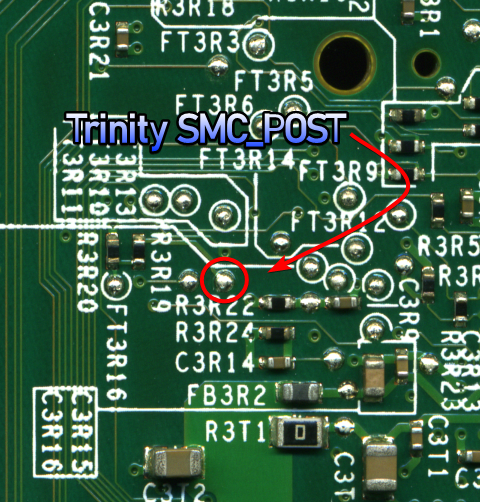Xbox 360:RGH/RGH3: Difference between revisions
No edit summary |
|||
| Line 1: | Line 1: | ||
{{Warning|The steps on this page are considered risky for your console, as there is a chance you can brick it. Please have someone else mod your console if you are not experienced in soldering!}} | |||
{{Notice|Phat consoles tend to be more stubborn with RGH3, and may have inconsistant booting behavior. It is recommended to use [[Xbox_360:RGH/RGH1.2|RGH 1.2]] on a phat system, as it will be more stable.}} | |||
RGH 3 is a modern method of the Reset Glitch Hack that uses the SMC in the Xbox 360's southbridge instead of a glitch chip in order to boot unsigned code. | RGH 3 is a modern method of the Reset Glitch Hack that uses the SMC in the Xbox 360's southbridge instead of a glitch chip in order to boot unsigned code. | ||
MrMario2011 has video guides for RGH 3 on Falcon/Jasper<ref>https://youtu.be/Gq1Svm-s-DM?si=bU1ANSEJRyFRf-G9</ref>, Trinity<ref>https://youtu.be/D3DDglRBqfY?si=nOD4cB6T6_gaQLwp</ref>, and Corona <ref>https://youtu.be/hpOlGeCHwro?si=CQHohmwYaSVUqG-F</ref> motherboards respectively. The guides from Larvs on Xbox 360 Hub<ref>https://xbox360hub.com/guides/rgh-3-guide/</ref> and BeefyDJ on Se7enSins<ref>https://www.se7ensins.com/forums/threads/rgh-3-0-guide-phat-slim-includes-quick-tool.1832979/</ref> are also great resources for RGH 3 tutorials. | MrMario2011 has video guides for RGH 3 on Falcon/Jasper<ref>https://youtu.be/Gq1Svm-s-DM?si=bU1ANSEJRyFRf-G9</ref>, Trinity<ref>https://youtu.be/D3DDglRBqfY?si=nOD4cB6T6_gaQLwp</ref>, and Corona <ref>https://youtu.be/hpOlGeCHwro?si=CQHohmwYaSVUqG-F</ref> motherboards respectively. The guides from Larvs on Xbox 360 Hub<ref>https://xbox360hub.com/guides/rgh-3-guide/</ref> and BeefyDJ on Se7enSins<ref>https://www.se7ensins.com/forums/threads/rgh-3-0-guide-phat-slim-includes-quick-tool.1832979/</ref> are also great resources for RGH 3 tutorials. | ||
==Equipment Needed== | ==Equipment Needed== | ||
| Line 23: | Line 24: | ||
**[[Xbox_360:4GB_NAND|4GB Corona NAND]] | **[[Xbox_360:4GB_NAND|4GB Corona NAND]] | ||
**[[Xbox_360:Standard_NAND|Any other NAND type]] | **[[Xbox_360:Standard_NAND|Any other NAND type]] | ||
==Reading your NAND== | |||
There are a few different tools for reading your NAND chip: xFlasher 360, Nand-X, JR Programmer, Matrix USB NAND Flasher, PicoFlasher, various SD card tools, or a LPT cable. However, the 4GB Corona requires that you use an xFlasher 360, PicoFlasher, Element18592's 4GB USB tool, or an SD card tool. Consider the pros and cons below and choose the method that’s right for you. The LPT cable method is not recommended, as it's extremely slow, requires more work than other options, and cannot be used to program glitch chips. | |||
===[[Xbox_360:4GB_NAND|4GB Corona]]=== | |||
{| class="wikitable" | |||
! Device | |||
! Pros | |||
! Cons | |||
|- | |||
| '''xFlasher 360''' | |||
| | |||
* Reads NAND fast in 40 seconds to 4 minutes | |||
* Can also program glitch chips | |||
* Actively supported | |||
* USB-C | |||
| | |||
* More expensive than SD Card tools or PicoFlasher | |||
|- | |||
|'''PicoFlasher''' | |||
| | |||
* Reads NAND in 1-8 minutes | |||
* Super cheap | |||
* Easy to find | |||
| | |||
* You will need a programmer to program glitch chips | |||
|- | |||
| '''4GB USB Tool''' | |||
| | |||
* Cheap | |||
| | |||
* You will need a programmer to program glitch chips | |||
|- | |||
| '''SD Card Tool''' | |||
| | |||
* Super cheap | |||
* Easy to find | |||
| | |||
* You will need a programmer to program glitch chips | |||
|} | |||
===[[Xbox_360:Standard_NAND|All Other Motherboards]]=== | |||
{| class="wikitable" | |||
! Device | |||
! Pros | |||
! Cons | |||
|- | |||
| '''xFlasher 360''' | |||
| | |||
* Reads NAND fast in 40 seconds to 4 minutes | |||
* Can also program glitch chips | |||
* One of four options for 4GB Corona | |||
* Actively supported | |||
* USB-C | |||
* Uses signed drivers | |||
| | |||
* Most expensive flasher | |||
* Can't be used for flashing Sonus Sounds | |||
|- | |||
| '''PicoFlasher''' | |||
| | |||
* Reads NAND fast in 1-8 minutes | |||
* One of four options for 4GB Corona | |||
* One of the two options for Sonus or Slim sound programming | |||
* Super cheap | |||
* Easy to find | |||
* Uses signed drivers | |||
| | |||
* Can't easily be used to flash glitch chips | |||
|- | |||
| '''Nand-X''' | |||
| | |||
* Reads NAND in 2-8 minutes | |||
* Can also program RGH glitch chips | |||
| | |||
* More expensive than most NAND flashers | |||
* Not much cheaper than the xFlasher | |||
* Does not support 4GB Coronas | |||
* Requires unsigned drivers | |||
|- | |||
| '''JR Programmer''' | |||
| | |||
* Reads NAND in 3-10 minutes | |||
* Can also program glitch chips | |||
* One of the two options for Sonus or Slim sound programming | |||
* Cheap | |||
* Easy to find | |||
| | |||
* More expensive than PicoFlasher or Matrix | |||
* Does not support 4GB Coronas | |||
* Requires unsigned drivers | |||
|- | |||
| '''Matrix USB NAND Flasher''' | |||
| | |||
* Reads NAND in 7-26 minutes | |||
* Super cheap | |||
| | |||
* Can’t be used for programming glitch chips [[Xbox_360:Matrix Programmer|unless you modify it]] | |||
* Does not support 4GB Coronas | |||
* Requires unsigned drivers | |||
|- | |||
|'''LPT Cable''' | |||
| | |||
* Cheap | |||
* Doesn't require unsigned drivers | |||
| | |||
* Requires PC with a native parallel port and more equipment | |||
* More difficult | |||
* Can’t be used for programming glitch chips | |||
* Takes 30-150 minutes to read NANDs | |||
|} | |||
==RGH3 Wiring & Diagrams== | ==RGH3 Wiring & Diagrams== | ||
Revision as of 04:12, 18 November 2023
| The steps on this page are considered risky for your console, as there is a chance you can brick it. Please have someone else mod your console if you are not experienced in soldering! |
| Phat consoles tend to be more stubborn with RGH3, and may have inconsistant booting behavior. It is recommended to use RGH 1.2 on a phat system, as it will be more stable. |
RGH 3 is a modern method of the Reset Glitch Hack that uses the SMC in the Xbox 360's southbridge instead of a glitch chip in order to boot unsigned code.
MrMario2011 has video guides for RGH 3 on Falcon/Jasper[1], Trinity[2], and Corona [3] motherboards respectively. The guides from Larvs on Xbox 360 Hub[4] and BeefyDJ on Se7enSins[5] are also great resources for RGH 3 tutorials.
Equipment Needed
- A soldering iron, solder, flux, and Isopropyl alcohol with cotton swabs
- 28-30AWG Wire (Solid core recommended)
- An SMD or through hole (Required on Phat, optional on Slim)
- Falcon/Jasper: 22K Ohm (Red, Red, Orange, Yellow)
- Trinity: 3K-10K Ohm
- 10K resistor color values are Brown, Black, Red, Gold
- Some Trinity consoles can occassionally have issues with RGH3 when using a high Ohm resistor, so it's best to start with around 3K if using one.
- Corona: 1K Ohm (Brown, Black, Red, Gold)
- 1N4148 diode (Only Falcon/Jasper, highly recommended)
- Wire Insulation (kapton tape, electrical tape, heatshrink, etc.) if using a through hole resistor/diode
- A PC running Windows Vista or later
- J-Runner with Extras
- Any compatible NAND Programmer (Listed in the NAND backup page)
- NAND Backup with RGH3 XeLL written to the console
Reading your NAND
There are a few different tools for reading your NAND chip: xFlasher 360, Nand-X, JR Programmer, Matrix USB NAND Flasher, PicoFlasher, various SD card tools, or a LPT cable. However, the 4GB Corona requires that you use an xFlasher 360, PicoFlasher, Element18592's 4GB USB tool, or an SD card tool. Consider the pros and cons below and choose the method that’s right for you. The LPT cable method is not recommended, as it's extremely slow, requires more work than other options, and cannot be used to program glitch chips.
4GB Corona
| Device | Pros | Cons |
|---|---|---|
| xFlasher 360 |
|
|
| PicoFlasher |
|
|
| 4GB USB Tool |
|
|
| SD Card Tool |
|
|
All Other Motherboards
| Device | Pros | Cons |
|---|---|---|
| xFlasher 360 |
|
|
| PicoFlasher |
|
|
| Nand-X |
|
|
| JR Programmer |
|
|
| Matrix USB NAND Flasher |
|
|
| LPT Cable |
|
|
RGH3 Wiring & Diagrams
Phat (Falcon/Jasper)
On Falcon and Jasper motherboards, you can place the a diode on the wire that connects POST and SMC_POST. While it could be skipped, is not recommended to use RGH 3 on a Falcon or Jasper without this diode, as the boot times will be more unstable or inconstant without it.
The diode's cathode end (the side with a black band) connects to POST, whereas its anode end connects to SMC_POST. Make sure the polarity is correct.
When using a through hole diode, it is recommended to solder it in the middle of the wire instead of soldering it directly to a pad. The wires will be less stiff than the diode's legs, causing less strain to the joint if it moves around. This also applies to the 22K resistor on the wire connecting PLL and SMC_PLL.
It is not recommended to use RGH 3 on Falcon or Jasper without the suggested resistor.
CPU Solder Points
CPU PLL
CPU POST
SMC Solder Points
Slim (Trinity)
On Trinity, it is recommended to use a 3K to 10K Ohm resistor on the PLL wire. The resistor on Trinity is optional, but recommended for reliability if available. The diode on the POST wire is not used on Trinity or Corona. When using a through hole resistor, it is recommended to solder it in the middle of the wire instead of soldering it directly to a pad. The wires will be less stiff than the diode's legs, causing less strain to the joint if it moves around.
CPU Solder Points
SMC Solder Points
Slim or E (Corona/Waitsburg/Stingray)
The 1K Ohm resistor on Corona motherboards is optional, but still recommended for reliability if available. It also connects to the wire connecting SMC_PLL and the CPU's PLL. When using a through hole resistor, it is recommended to solder it in the middle of the wire instead of soldering it directly to a pad. The wires will be less stiff than the diode's legs, causing less strain to the joint if it moves around. Make sure to check if the POST point on the bottom is enabled or not using the provided diagram.
CPU Solder Points
SMC Solder Points
Decrypting the NAND
- Connect an Ethernet cable and HDMI cable to the console and power it on. The glitch chip should blink once or more times, and then the console should start into XeLL RELOADED.
- Once XeLL finishes, it will display your CPU key and some other info. There is also an IP address.
- Enter the IP address into the box on the lower right of J-Runner and click "Get CPU Key". J-Runner will pull the info from the box, and decrypt the NANDs automatically.
- If you don't want to or aren't able to connect the Xbox 360 to a network or directly to the PC, you can also manually type in the CPU key from XeLL into J-Runner.
Writing New NAND Image
- Power down the console, and connect your programmer to the motherboard.
- If you are using an xFlasher, ensure the switch is set to
SPI.
- If you are using an xFlasher, ensure the switch is set to
- In the upper right of J-Runner, ensure the
Glitch2radio button is selected. Since RGH3 XeLL was written to the NAND earlier, Glitch2 and RGH3 should already be enabled. - Click "Create XeBuild Image". This will take a few moments.
- Click "Write NAND".
- Disconnect your programmer when the process completes.
- Boot the console several times and ensure it boots consistently. If not, make sure your wiring is clean and neat and avoids noisy areas. Run the wires near the X-Clamps for best results.
- Return to the RGH main page and continue in the Cleaning Up section.
